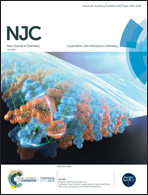TbIII/3d–TbIII clusters derived from a 1,4,7-triazacyclononane-based hexadentate ligand with field-induced slow magnetic relaxation and oxygen-sensitive luminescence†
Abstract
A family of new TbIII and 3d–TbIII cluster complexes, namely [Tb(L)(CH3COCH3)] (1), [Tb2(μ-H2O)(L)2] (2), [Zn2Tb(L)2]·ClO4 (3) and [Ni2Tb(L)2]·ClO4 (4) (H3L = N,N′,N′′-tris(3,5-dimethyl-2-hydroxybenzyl)-1,4,7-triazacyclononane), have been synthesized through the reaction of H3L and metal salts. Structural analysis reveals that 1 and 2 exhibit mononuclear and binuclear structures, respectively, and both 3 and 4 exhibit trinuclear 3d–4f–3d structures. Interestingly, complex 1 could undergo reversible transformation to complex 2 by adjusting the reaction solvents. The alternating current (ac) magnetic susceptibilities of 3 reveal that out-of-phase (χ′′) is frequency- and temperature-dependent, which is a typical feature of field-induced slow magnetic relaxation with an energy barrier of 35.71 K. Moreover, complexes 1–3 show strong oxygen-sensitive luminescence, with typical narrow emission bands of lanthanide ions. The luminescence intensity and lifetime (5D4 of TbIII) of 3 are obviously stronger than those of 1 and 2. Therefore, complex 3 can be considered as a good candidate as a bi-functional magneto-luminescent molecular material.



 Please wait while we load your content...
Please wait while we load your content...